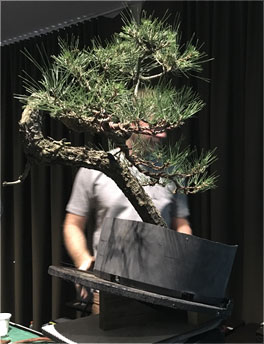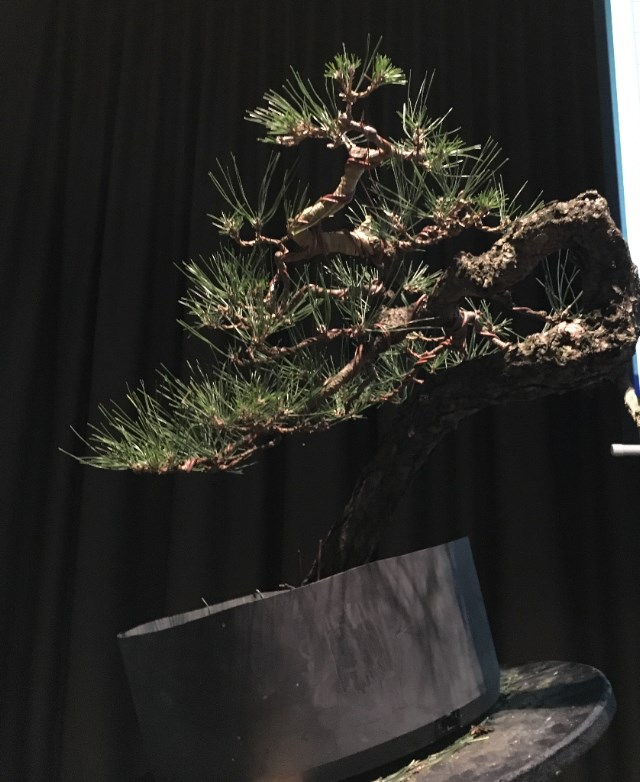What a wonderful AABC Convention this year; great demonstrators, a fantastic show (see our website for photos) and an excellent group of like-minded people with whom to share the experience. Congratulations to Bonsai Northwest Inc who left nothing to chance and made sure that the 31st AABC Convention was a memorable experience for all those involved.
 Bjorn Bjorholm (USA) was the star attraction and over the weekend he worked on four trees, ably assisted by Joe Morgan-Payler who wired tirelessly and without complaint! Saturday’s trees were a Japanese black pine and a very lush white pine and Sunday’s a Juniper chinensis and another black pine. At the end of each day the ‘finished’ trees were auctioned.
Bjorn Bjorholm (USA) was the star attraction and over the weekend he worked on four trees, ably assisted by Joe Morgan-Payler who wired tirelessly and without complaint! Saturday’s trees were a Japanese black pine and a very lush white pine and Sunday’s a Juniper chinensis and another black pine. At the end of each day the ‘finished’ trees were auctioned.
The features and flaws of each tree are Bjorn’s starting point, with the obvious aim of using the best features and correcting (if possible) or disguising the flaws. Bjorn starts at the roots and works his way up the trunk to decide a tree’s future; features and correcting (if possible) or disguising the flaws. Bjorn starts at the roots and works his way up the trunk to decide a tree’s future.
Saturday’s Japanese black pine was a well grown, 20-30 year old tree with good bark. Unfortunately, its root structure wasn’t very wide so Bjorn just had to work with what was there and move on to the trunk line, which had the positive features of movement, developed bark and potential for a shari to create interest but also a large scar and a ‘bit of a pigeon’s breast’ or belly. To disguise these flaws a viewing angle was chosen to hide the scar and the belly but also leave plenty of branches to work with. By changing the planting angle slightly, the apex was now above the base and the better features more obvious.
Next all the unnecessary branches were removed going back to a basic bifurcating (two) branch structure but always leaving a short stub to make sure the remaining branches don’t die back. Anything growing up or down on lateral branches was removed as were long, leggy branches unless the branch was the only one and then it was kept. Bjorn works from the bottom and the inside of the tree so as not to break or bend the needles on surrounding branches as they are easily damaged.
Mid-winter is a good time to work on black pines because the autumn growth has hardened and removing 35-40% of the foliage of a healthy black pine is ‘no problem’. In the case of this black pine, about 20% of the foliage was removed. Bjorn doesn’t cut needles, preferring to balance the tree’s energy by plucking the needles. His rule of thumb is; if a branch is weak, it is left alone, if it is moderately strong then 10-12 pairs of needles are left in a radial pattern while strong branches are reduced to 6-8 pairs of needles.
As Japanese black pines are a double flush pine, Bjorn staggers his summer decandling regime. The earlier a tree is decandled, the longer the needles have to grow so larger trees are done first and the smallest trees last. He decandle and pluck at the same time to let the light in and promote growth. If there is not enough back budding, Bjorn fertilises heavily from the decandling stage but is aware that it could take a couple of years to get the necessary back budding.
Finally the wiring was done (Joe did this while Bjorn started the white pine). When wiring pines Bjorn uses a much wider angle than the conventional 45° and keeps his wiring ‘nice and clean’ with no crossing wires. He uses copper wire for pines a third to half the diameter of the branch being wired.

Bjorn wants the branches to be visually powerful so he uses a line of best fit so there is some movement up and down and a little bit side to side but no humps or bends, and avoids branches ending on the same horizontal plane at all cost. He feels and listens as he bends and lets a branch rest for a little while before bending more.
This tree will need some grafting in the apex later because there is not enough foliage. The aim is to have a nice dome shape and not a helmet look.
And finally Bjorn’s advice to beginners:
• Don’t buy too much
• Focus on quality not quantity
• You will have better trees if you have less as you will have enough time to work on them
